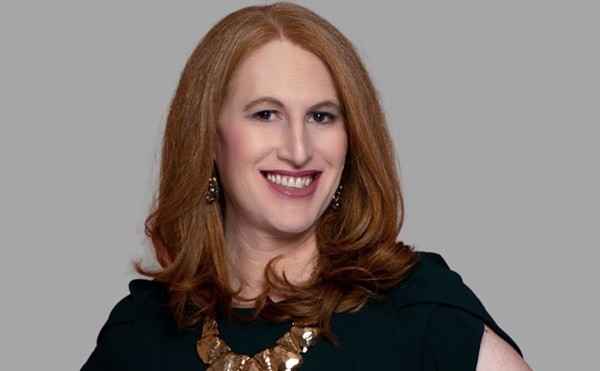Inside a studio tucked into the Alfond Sports Center at Rollins College, floor-to-ceiling mirrors line a lengthy wall, reflecting the glossy wooden floor where two ballroom-dancing partners are practicing their moves. You can watch the action on the floor and the reflection in the mirror simultaneously as the couple sweeps from one end of the studio to the other in a whirl of twists, turns and footwork that's so fast, it's difficult for a camera shutter to capture a still moment. The dancers cover almost every inch of the floor, and that's why I'm crouching in the corner; for safety, theirs and mine. When they stop, you hear their winded breath and see the sweat. An hour of ballroom dancing burns off about as many calories as boxing a punching bag.
On this day, the two are perfecting a waltz for an upcoming competition in London. In front of a fast rhythm (174 to 180 beats per minute), the duo dances to classical music; one, two, three; one, two, three; with a strong accent on the "one." Each step has a name: natural fleckerl, reverse fleckerl, contra check. They step into the contra position, both the leader and follower moving together – leader going forward, follower going backward. The bodies are torqued into a "contrary" position, when suddenly the leg movement is checked, while the torsos continue to travel. The leader steps forward on his left leg and turns his body left, finishing with a dramatic lunge that leaves the follower bent back, head tipped, with an expression that's close to ecstasy. The performance is athletic, elegant and romantic. These guys know how to dance.
It's taken several months of rehearsal to bring Stuart Nichols, 42, and Richard Lamberty, 46, leader and follower respectively, to this level. (The leader role typically falls to the tallest in the couple.) Dark-haired Nichols, who is lanky and hard-bodied; and redheaded Lamberty, a fair-skinned cherub, are dance partners. And, yes, they are gay, but not lovers. To say they are fast on their feet doesn't even come close to capturing the level of mastery they've achieved in the waltz, tango, slow foxtrot, Viennese waltz and quickstep, the traditional dances that make up standard ballroom. It is breathtaking to watch them in action – the speed, agility and grace – once you get over the fact that there's no woman in the equation. This is not something you'll see on Dancing With the Stars.
Almost two weeks after that practice, Nichols and Lamberty returned from the Pink Jukebox Trophy event in London having placed fourth among 22 couples in the men's "standard ballroom" round. The veteran Orlando dance instructors say they were the oldest couple on the floor in their category, open to both men and women, though they compete only with their own gender. (Currently, more women than men are involved in competitive same-sex ballroom dancing. In London, there were 29 female couples to 22 men couples.) So, the achievement is well earned. Same-sex competition is more forgiving of age, though even the reigning men's world champions – Vesselin Bairski (of Bulgaria) and Detlev Mueller (of Germany) – are barely in their 30s.
In the world of straight ballroom competition, Nichols and Lamberty concede, they would be considered "really old." So the growing calendar and status of same-sex competition has given them a new realm to conquer. Fortified by their placement in the European competition, the two dancers are circling in like sharks on their goal: winning at the Gay Games VII in Chicago this July, the Olympics of gay sports. Then they move on in October to the second annual World Federation of Same-Sex Dancing World Championships in Budapest, Hungary.
For now, though, they are concentrating on an age-old dilemma: What to wear?
In London, black was their color – Nichols in tails, Lamberty in a vest – the same as all the other couples in their competition. Such classic men's costumes make for a visual challenge, says Nichols, and "require refining the lines that incorporate the skill itself." In other words, with two men dressed in black, there's no leggy eye candy or twirling skirts to capture the fancy of viewers. It's like Fred Astaire dancing with Fred Astaire.
The London competition displayed a trend among competing women's couples for custom-made "pantsy things," says Nichols. The cleverly coordinated costumes allow for twirl and flow without baring skin, still showing off the things they are supposed to show off, such as how the couple is "glued" together.
In the men's Latin category, things were spicy. One male follower was dressed in a bustier and others were adorned in frocks and feathers. (Such frilly fare is not accepted in men's standard ballroom dance.)
Nichols and Lamberty say performing in London was the most fun they had ever had in competition. Their strength as a team lies in how well they are partnered together. As the leader, Nichols is responsible for the "floor craft," or the navigation of the team around the room amidst a crowd of other couples, always flowing counter-clockwise. He calls the shots and can choose proper etiquette or dirty moves, such as aggressively cutting someone off by charging into their space. Lamberty is the follower, the star of the show, who is led into theatrical movements and poses that put his skills on display.
They can and do change up on the leader/follower roles in the middle of a dance. It's not something that would be noticed, except by a trained eye, but it is difficult to execute.
"Richard is an extremely accomplished, highly respected dancer. This has been the first opportunity for me to dance with somebody I had to dance up to," says Nichols. "Richard is coming from a stronger place than I am."
Nichols, on the other hand, is a ham. Says Lamberty: "He's a proficient ballroom dancer, with 20 years of competition experience." He puts on a performance with a showy style that Lamberty says is distinctly American.
The intensive hours of training came together in London. "The things we tried just clicked," says Nichols. "Our expectations were exceeded," says Lamberty. "We were off the charts."
For clarification, Nichols and Lamberty are experienced dancing with women, as students and as competitive partners. Same-sex dancing is something they do because they enjoy the experience. They are gay, but not all same-sex competitors are gay. Most of all, they dance together because it's a path back into international competition.
"The fun thing about dancing with a man is that the power and strength you can generate with two men is different than with a man and woman," says Nichols. "The energy manifests differently with two men or two women," adds Lamberty. Strength plus strength makes the dancing more powerful.
Ultimately, says Nichols, "It's really not about sex; it's really about dancing."
Nichols and Lamberty were both born in Winter Park, though their evolution into dance progressed at different paces. Nichols says that during his childhood he moved around to different cities, graduating high school in Alabama. He says he never had any interest in dancing until he started college. That's when he saw an ad in the paper that said: "How would you like to sleep later in the morning and stay up late at night?" Nichols' response was: "That's my career right there."
"Seriously," Nichols says, "I dropped out of college" for this job of teaching dance, and he's been doing it ever since, moving back to Orlando in 1992. Nichols now teaches partner dancing to individuals and groups at The Zebra Room studio, as well as classes for the city of Winter Park and Rollins College. He is an experienced instructor, understanding the difficulties in the role of leader and follower, and can break down the puzzling complexities to students.
Lamberty, however, grew up in Winter Park and started dancing at age 10. "I was with the Orlando Cloggers, a teen square dance/clogging group that was run by the city of Orlando. My parents had taken up square dancing, and I saw them dancing and I was fascinated. They put me in this program with one of my brothers and sisters, and I loved it, and they didn't, so I kept doing it. And I started doing the ballroom stuff when I was about 14. By the time I was in college, I was much more involved." He has competed in same-sex competition, starting in San Francisco, where he lived until his recent return to Orlando. His other occupation is software.
After years and careers in dancing, the decision by Nichols and Lamberty to dance together competitively had nothing to do with sexual attraction or activism, though controversy is inherent in the sport.
"The way that `same-sex dancing` has developed is that it is almost completely separate and isolated from the regular ballroom world," says Lamberty. That's because traditional ballroom doesn't want it. There's a fear of being associated with same-sex dancing, even though in traditional competition it is well known that "there are a lot of men who are gay," says Nichols. But when it comes to the same-sex variety, "There's an undercurrent of almost phobia of homophobia," he says.
Lamberty tells of one particular female couple who watched a same-sex competition in 1998 and then went home to Vienna to learn to dance, but couldn't find a teacher who would teach them because they were gay. "Over the next four years, they finally got someone to teach them. They became quite good and went to Sydney and were competing in one of the higher divisions. Later they established a same-sex competition in Vienna."
Even today, Lamberty says, on the competitive level, it can be difficult in the United States to find a coach or a place to dance. In San Francisco, he says, "a lot of coaches would work with us but a lot of them would not. They were afraid for their careers." He and Nichols found their coach in Tampa, where they drive for instruction.
Gay "dancesport" is the beefed-up name for competitive same-sex ballroom dancing. It's also known as "alternative," "same-gender" or "equality" dancing. Dancesport is one of five new events added this year to the July 15 to 22 Gay Games in Chicago. Also included for the first time are rugby, darts, flag football and billiards, for a total of 30 sporting events that will attract athletes from around the world.
Same-sex ballroom dancing is, in fact, growing in popularity, both in the United States and more so in Europe and Australia. There is an expanding calendar of global same-sex events and an increasing number of ballroom dance clubs, all of which bolster the sport and raise the skill level of dancers.
In Orlando, there are no outlets for same-sex dancing. Not so much because there's outright opposition to it, but because no one's doing it. It was only within the last month that a couple of lesbian women came to Nichols and asked if he would teach them ballroom dance. On both the recreational and competitive levels, it's well known that more women are same-sex dancing than men. "Socially, people have never had a problem with two women dancing together," says Nichols. "But two men dancing together has always been more shocking."
In contrast, Lamberty says, London is full of straight and gay dance clubs, because there has been an "explosion" of dance in Europe. According to Lamberty, Holland is the oldest supporter of competition, having hosted for more than 25 years, and the German government even subsidizes its country's same-sex dance clubs and events.
There are same-sex dance clubs sprinkled throughout the U.S., following the European trend. For instance, Portland's Out Dancing organization celebrated its 11th anniversary this month. Another group operating in Los Angeles and Long Beach since 2001 is Out Dancing Ballroom, which claims to be the only same-sex ballroom troupe in the world.
How cutthroat dancesport games will be in Chicago is at question because there's been a ruckus surrounding the Games. Just after the Gay Games wrap up, another same-sex world dance competition makes its debut at the OutGames, July 29 to Aug. 5 in Montreal. It's been a catfight, with both events wooing the international community. The Gay Games are where Nichols and Lamberty hope to leave a lasting impression. They will be the only competitors from Orlando.
If you're still uncomfortable with the concept of same-sex ballroom dancing, consider it just another twist in the scandalous annals of dance.
"There are still people who find it offensive for a man to dance with someone other than his wife," says Nichols. "The waltz was scandalous when it first came about because you actually touched your partner's waist," says Lamberty.
[email protected]
















